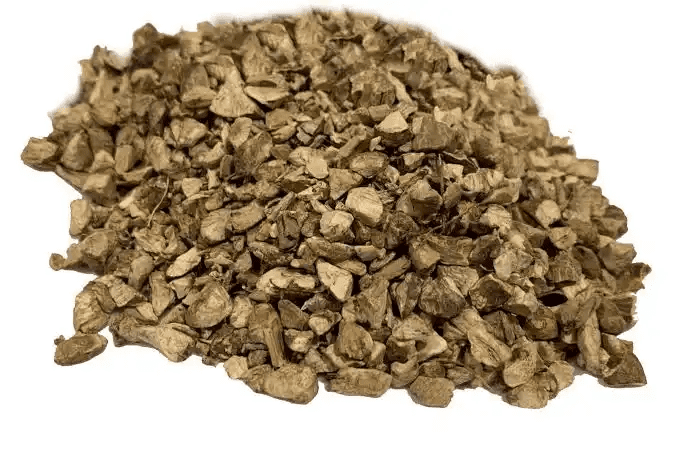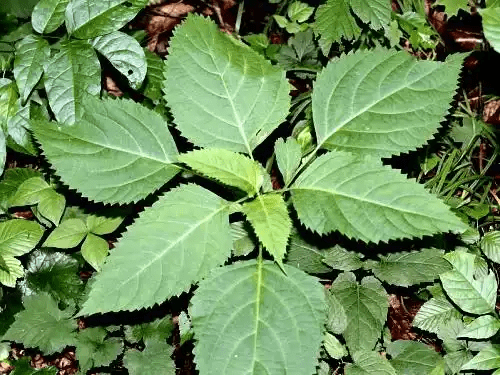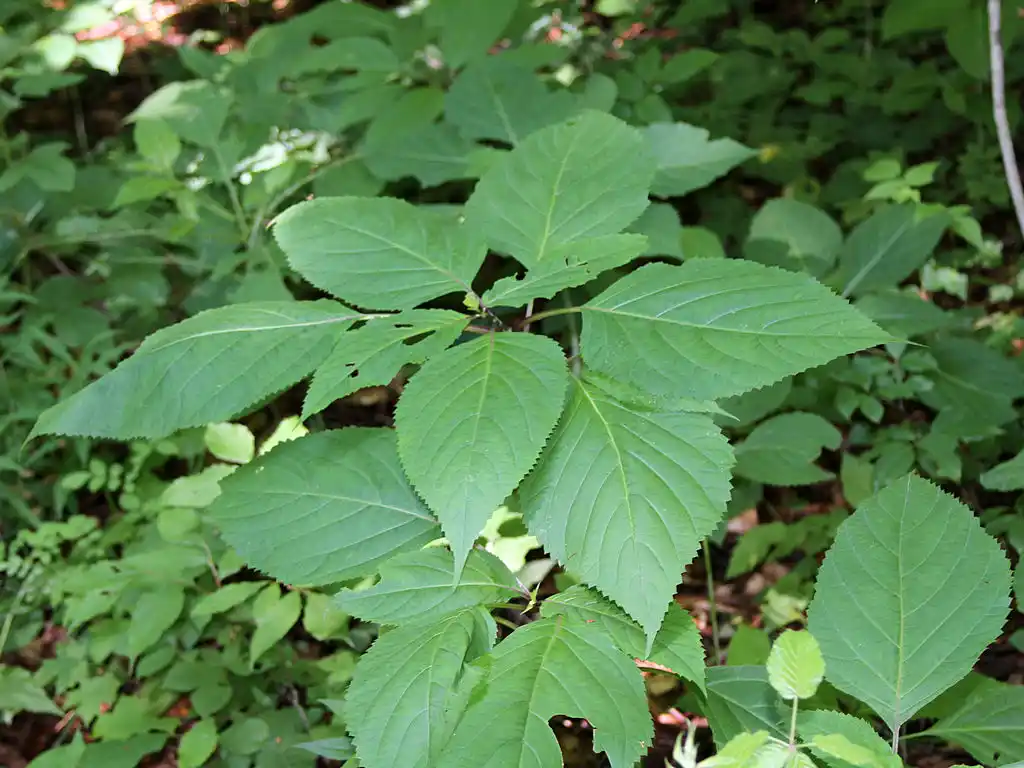Stone Root, scientifically known as Collinsonia canadensis, is a perennial herb native to North America. This herbaceous plant belongs to the mint family, Lamiaceae, and is primarily found in the eastern part of the United States and Canada.
Stone Root has a long history of traditional use, particularly among Native American communities, and it continues to be explored for its potential medicinal properties.
The name “Stone Root” is derived from the traditional use of the plant’s roots in herbal medicine, where it was historically believed to address urinary and kidney issues.
The scientific name “Collinsonia canadensis” honors the English botanist Peter Collinson and the plant’s Canadian origin.
Stone Root is characterized by its tall, slender stems, heart-shaped leaves, and clusters of small, tubular flowers that can range in color from white to pale yellow.
The plant typically grows in moist woodland areas and along stream banks, favoring habitats with rich, well-drained soil.
In traditional herbal medicine, Stone Root has been used for various purposes, including as a diuretic, astringent, and tonic. The plant’s roots were historically prepared as infusions or tinctures and consumed for their purported ability to support the urinary system and address conditions such as kidney stones and urinary tract infections.
One of the primary traditional uses of Stone Root is associated with its potential to promote kidney and bladder health. The herb is believed to have diuretic properties, which means it may increase urine production and help in the elimination of waste from the body. Additionally, Stone Root has been used to address conditions related to water retention and swelling.
While Stone Root has a history of traditional use, it’s important to note that scientific research on its medicinal properties is limited, and more studies are needed to validate its effectiveness and safety.
As with any herbal remedy, individuals considering the use of Stone Root for health purposes should consult with healthcare professionals, especially if they have existing medical conditions or are taking other medications.
In contemporary herbalism, Stone Root is sometimes included in formulations aimed at supporting the urinary system or addressing conditions associated with fluid retention.
However, it’s crucial to approach its use with caution and under the guidance of qualified healthcare practitioners.
The Botanical Description of Stone Root
1. Eupatorium purpureum: Stone root, scientifically known as Eupatorium purpureum, is a perennial herbaceous plant belonging to the Asteraceae family. This robust herb stands tall, typically reaching heights of 3 to 6 feet. It features a sturdy stem and striking purple-pink flowers that bloom in dense clusters.
2. Leaves and Foliage: The leaves of stone root are serrated and lance-shaped, growing opposite each other along the stem. Sporting vibrant green hues, the foliage varies in size, with larger leaves toward the plant’s base.
3. Root System: The roots of stone root are distinctive—thick, knotty, and often resembling stones. These roots anchor the plant securely into the soil while absorbing vital nutrients.
4. Habitat and Growing Conditions: Native to North America, stone root thrives in woodlands, meadows, and along riverbanks. It adapts well to diverse soil types, preferring moist, well-drained soils, and can flourish in sunlit or partially shaded environments.
5. Bloom Time: Stone root’s flowering period spans late summer to early fall, showcasing clusters of captivating purple-pink flowers. This phase attracts pollinators like bees and butterflies, vital for the plant’s lifecycle.
The Geographic Distribution of Stone Root
1. Native Regions: Indigenous to eastern North America, stone root spans from Canada to parts of the United States. It primarily inhabits deciduous woodlands, thriving in temperate climates.
2. Woodlands and Wet Areas: Commonly found in wooded areas, stone root also grows along riverbanks and in wet meadows. Its adaptability to moist environments allows it to flourish in these habitats.
3. Cultivation Beyond Native Range: Due to its ornamental and medicinal value, stone root is cultivated beyond its native territories, often in controlled environments by gardeners and herbal enthusiasts.
4. Naturalization: Stone root exhibits naturalization tendencies, spreading to areas with favorable climates and soil conditions, establishing self-sustaining populations beyond intentional cultivation.
The Chemical Composition of Stone Root
1. Euparin and Eupafolin: Stone root contains compounds like euparin and eupafolin, showcasing anti-inflammatory and antioxidant effects.
2. Terpenoids: These compounds contribute to stone root’s resilience and ability to thrive in varied environmental conditions.
3. Essential Oils: The roots of stone root contain essential oils that contribute to its aromatic profile and potential therapeutic benefits.
4. Triterpenes: Known for their diverse biological activities, triterpenes in stone root may aid in the plant’s adaptation to stressors.
5. Polyphenolic Compounds: Stone root’s rich content of polyphenolic compounds contributes to its antioxidant properties.
6. Tannins: These astringent compounds found in stone root have historical uses in traditional medicine.
7. Medicinal Alkaloids: Stone root may contain alkaloids with potential medicinal significance.
8. Resins: Resinous compounds found in stone root could play protective roles for the plant.
9. Beta-Sitosterol: Stone root contains beta-sitosterol, known for cholesterol-lowering properties.
10. Anti-Inflammatory Sesquiterpenes: Certain sesquiterpenes found in stone root exhibit anti-inflammatory characteristics.
Read Also: 14 Medicinal Health Benefits Of Voacanga africana (Small-fruit wild frangipani)
The Medicinal Health Benefits Of Stone Root (Collinsonia canadensis)

1. Anti-Inflammatory Properties: Stone root is celebrated for its potent anti-inflammatory effects, making it a valuable asset in alleviating conditions marked by inflammation, such as arthritis.
2. Digestive Aid: This medicinal herb aids digestion by promoting a healthy balance of digestive juices and enzymes, contributing to improved gastrointestinal function.
3. Respiratory Support: Stone root has been traditionally used to address respiratory issues, including coughs and congestion, providing relief and supporting overall respiratory health.
4. Urinary Tract Health: Stone root is recognized for its positive impact on the urinary system, potentially assisting in maintaining urinary tract health and preventing infections.
5. Anti-Spasmodic Effects: The herb exhibits anti-spasmodic properties, which can help relax muscle spasms, providing relief to individuals dealing with conditions such as muscle cramps.
6. Diuretic Action: Stone root may act as a diuretic, promoting increased urine production and facilitating the elimination of toxins from the body.
7. Immune System Support: Regular consumption of stone root is believed to bolster the immune system, enhancing the body’s ability to fend off infections and illnesses.
8. Cardiovascular Health: Stone root has been associated with cardiovascular benefits, including the potential to support healthy blood pressure levels and promote overall heart health.
9. Anti-Anxiety Effects: Some herbalists suggest that stone root may have calming effects on the nervous system, potentially helping individuals manage anxiety and stress.
10. Antioxidant Protection: The presence of antioxidants in stone root contributes to its ability to neutralize free radicals, offering protection against oxidative stress.
11. Wound Healing: External applications of stone root may aid in wound healing, with its potential to reduce inflammation and promote tissue regeneration.
12. Antimicrobial Properties: Stone root possesses antimicrobial properties that may contribute to its ability to combat certain infections and support the body’s defense mechanisms.
13. Menstrual Support: For individuals dealing with menstrual discomfort, stone root’s anti-inflammatory and muscle-relaxant properties may offer relief from cramps and pain.
14. Anti-allergic Effects: Stone root has been explored for its potential anti-allergic properties, with indications that it may help alleviate allergic reactions.
15. Liver Health: The herb is believed to support liver function, assisting in the detoxification processes crucial for overall health and well-being.
16. Anti-Rheumatic Benefits: Stone root’s anti-inflammatory properties extend to potential benefits for individuals dealing with rheumatic conditions, offering relief from joint pain and swelling.
17. Antispasmodic Action on the Digestive Tract: Stone root’s antispasmodic effects extend to the digestive tract, potentially easing conditions such as irritable bowel syndrome (IBS).
18. Anti-Hemorrhoidal Properties: Stone root is traditionally used for its potential to address hemorrhoids, offering relief from pain and discomfort associated with this condition.
The Methods of Usage to Achieve the Provided Health Benefits Of Stone Root (Collinsonia canadensis)
1. Herbal Infusion: Prepare a herbal infusion by steeping dried stone root in hot water. This tea can be consumed regularly to enjoy its various health benefits.
2. Tinctures: Tinctures are concentrated extracts of stone root, providing a convenient way to incorporate its medicinal properties into your routine. Follow recommended dosage guidelines.
3. Poultices: For external applications, create a poultice by blending crushed stone root with a suitable base. Apply the poultice to wounds or areas with inflammation for localized relief.
4. Capsules or Tablets: Stone root supplements in capsule or tablet form offer a standardized dosage, making it easier to integrate into your daily health regimen.
5. Dietary Additive: Incorporate dried and powdered stone root into your diet by adding it to smoothies, soups, or other culinary creations for a subtle yet consistent intake.
6. Herbal Syrups: Create herbal syrups by combining stone root extract with honey or another sweetener. This method offers a palatable way to enjoy the herb’s benefits.
7. External Wash: Stone root can be used externally as a wash for wounds or skin irritations. Prepare a diluted solution and apply it gently to the affected area.
8. Steam Inhalation: Inhaling steam infused with stone root can provide respiratory benefits. Add the herb to hot water, cover your head with a towel, and inhale the steam.
9. Compresses: Soak a cloth in a stone root infusion and apply it as a compress to areas with inflammation or swelling for targeted relief.
10. Culinary Uses: Explore culinary uses of stone root by incorporating it into recipes where its flavor complements the dish. This method is suitable for those who enjoy experimenting with herbs in the kitchen.
The Side Effects Of Using Stone Root Medicinal Plant
1. Allergic Reactions: Individuals with known allergies to plants in the Asteraceae family, such as ragweed, marigolds, or daisies, may experience allergic reactions to stone root.
2. Gastrointestinal Discomfort: Excessive consumption of stone root may lead to gastrointestinal discomfort, including nausea or digestive upset. Moderation is key.
3. Blood Pressure Interactions: Stone root’s potential to influence blood pressure means individuals on blood pressure medications should exercise caution and consult with a healthcare professional.
4. Pregnancy and Lactation: Pregnant or breastfeeding individuals should avoid using stone root due to limited safety data for these populations.
5. Drug Interactions: Stone root may interact with certain medications, especially those affecting blood pressure or blood clotting. Consultation with a healthcare provider is essential.
6. Skin Irritation: External applications of stone root may cause skin irritation in some individuals. Conduct a patch test before extensive use.
7. Diuretic Effects: Stone root’s diuretic properties may lead to increased urination. Individuals with kidney issues should use it cautiously and under medical guidance.
8. Sedative Effects: Stone root’s potential calming effects on the nervous system may enhance the sedative effects of certain medications. Use with caution if taking sedatives.
9. Liver Health: While stone root is generally considered supportive of liver health, individuals with liver conditions should consult a healthcare professional before use.
10. Interference with Medical Conditions: Individuals with pre-existing medical conditions, especially those related to the cardiovascular or digestive system, should seek professional advice before using stone root.
Read Also: Reasons why Boswellia Serrata is good for your health
The Scientific Research and Studies of Stone Root (Collinsonia canadensis)

1. Anti-Inflammatory Properties: Numerous scientific studies have delved into the anti-inflammatory properties of stone root. Research suggests that certain compounds within the herb may modulate inflammatory pathways, providing potential benefits for conditions associated with inflammation.
2. Antioxidant Effects: Scientific investigations have explored the antioxidant effects of stone root, indicating its capacity to neutralize free radicals. This antioxidant activity may contribute to the herb’s overall health-promoting properties.
3. Anti-Bacterial and Anti-Microbial Action: Stone root has been the subject of studies investigating its antibacterial and antimicrobial properties. These findings suggest that the herb may exhibit activity against certain pathogens.
4. Potential Cardiovascular Benefits: Research has hinted at potential cardiovascular benefits associated with stone root. Studies have explored its impact on blood pressure regulation and overall heart health.
5. Traditional Uses vs. Modern Research: Comparative studies have been conducted to bridge traditional uses of stone root with modern scientific understanding. This research aims to validate traditional medicinal applications and expand our knowledge of the herb’s therapeutic potential.
6. Impact on Respiratory Health: Scientific research has explored the impact of stone root on respiratory health. Investigations indicate potential benefits for conditions affecting the respiratory system, such as bronchitis or coughs.
7. Analgesic Effects: Some studies have investigated the analgesic effects of stone root. Findings suggest that the herb may possess pain-relieving properties, making it of interest for conditions involving discomfort.
8. Immune Modulation: Stone root’s potential to modulate the immune system has been a focus of scientific inquiry. Research suggests that the herb may influence immune responses, contributing to overall immune system health.
9. Adaptogenic Properties: Scientific investigations into stone root have explored its adaptogenic properties. These studies aim to understand how the herb may help the body adapt to stressors and maintain balance.
10. Hepatoprotective Potential: Certain studies have explored stone root’s hepatoprotective potential, indicating its ability to support liver health and protect against liver-related issues.
11. Effect on Allergic Reactions: Research has been conducted to examine the effect of stone root on allergic reactions. Findings suggest potential anti-allergic properties that may help alleviate symptoms associated with allergies.
12. Gastrointestinal Effects: Scientific studies have explored the impact of stone root on gastrointestinal health. Investigations indicate potential benefits for digestive issues, such as indigestion or irregular bowel movements.
The Safety Precautions and Recommendations In Using Stone Root (Collinsonia canadensis) Medicinal Plant
1. Dosage and Moderation: While stone root is generally considered safe when used appropriately, it is crucial to adhere to recommended dosage guidelines. Excessive intake may lead to adverse effects.
2. Allergic Reactions: Individuals with known allergies to plants in the Asteraceae family should exercise caution when using stone root, as allergic reactions may occur.
3. Consultation with Healthcare Professionals: Pregnant or breastfeeding individuals, as well as those with pre-existing medical conditions or individuals taking medications, should consult healthcare professionals before incorporating stone root into their health regimen.
4. Blood Pressure Medications: Stone root may influence blood pressure, and individuals on blood pressure medications should monitor their blood pressure closely and consult with healthcare providers.
5. Interaction with Sedatives: Stone root’s potential sedative effects may enhance the effects of sedative medications. Caution is advised, and consultation with healthcare professionals is recommended.
6. Skin Sensitivity: External applications of stone root may cause skin sensitivity in some individuals. A patch test is advisable before extensive use.
7. Potential Diuretic Effects: Stone root’s diuretic properties may lead to increased urination. Individuals with kidney issues should use it cautiously and under medical guidance.
8. Monitoring for Gastrointestinal Discomfort: Excessive consumption of stone root may lead to gastrointestinal discomfort. Users should monitor for symptoms such as nausea or digestive upset.
9. Pregnancy and Lactation: Due to limited safety data, pregnant or breastfeeding individuals should avoid using stone root without consulting healthcare professionals.
10. Liver Conditions: Individuals with liver conditions should seek professional advice before using stone root due to its potential impact on liver health.
11. Blood Clotting Disorders: Stone root may interact with medications affecting blood clotting. Individuals with blood clotting disorders should exercise caution and consult with healthcare providers.
12. Individual Sensitivity: Each individual’s response to stone root may vary. Users should pay attention to how their bodies react and adjust usage accordingly.
FAQs About Stone Root (Collinsonia canadensis) Medicinal Plant
1. Is Stone Root Safe for Long-Term Use?
Yes, stone root is generally considered safe for long-term use when taken in recommended doses. However, individuals should monitor for any adverse effects and consult healthcare professionals if needed.
2. Can Stone Root Be Used During Pregnancy?
It is advisable for pregnant individuals to avoid using stone root due to limited safety data for this population. Consulting healthcare professionals is crucial before considering its use during pregnancy.
3. How Does Stone Root Impact Blood Pressure?
Stone root may influence blood pressure. Individuals on blood pressure medications should monitor their blood pressure closely and consult healthcare providers for guidance.
4. Are There Any Known Drug Interactions with Stone Root?
Stone root may interact with certain medications, especially those affecting blood pressure or blood clotting. Consultation with healthcare providers is essential to prevent potential interactions.
5. Does Stone Root Cause Drowsiness?
Stone root’s potential sedative effects may cause drowsiness, especially when combined with sedative medications. Users should exercise caution and avoid activities requiring alertness if experiencing drowsiness.
6. Can Stone Root Be Applied Topically for Skin Issues?
Yes, stone root can be applied topically for certain skin issues. However, a patch test is advisable to check for skin sensitivity before extensive use.
7. What Are the Potential Allergic Reactions to Stone Root?
Individuals with allergies to plants in the Asteraceae family may experience allergic reactions to stone root. Symptoms may include itching, redness, or swelling. Discontinue use if such reactions occur.
8. Can Stone Root Help with Respiratory Conditions?
Research suggests that stone root may have positive effects on respiratory health, potentially aiding conditions such as bronchitis or coughs.
9. How Should Stone Root Supplements Be Stored?
Stone root supplements should be stored in a cool, dry place away from direct sunlight. Follow the storage instructions provided on the product packaging.
10. Is Stone Root Safe for Children?
It is advisable to avoid giving stone root to children without consulting healthcare professionals. The safety and appropriate dosage for children may vary, and professional guidance is essential.
11. Can Stone Root Be Used Alongside Other Herbal Supplements?
Combining stone root with other herbal supplements should be approached with caution. Consult healthcare professionals to ensure compatibility and prevent potential interactions.
12. Does Stone Root Have a Cumulative Effect Over Time?
The cumulative effects of stone root over time may vary among individuals. Regular monitoring for any changes in health or well-being is recommended.
Read Also: Banana Tree Care: What You Need to Know

